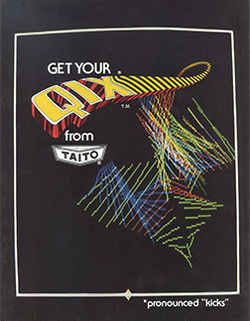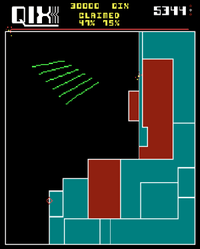Qix
| Qix | |
|---|---|
 Arcade flyer | |
| Developer(s) |
Taito (original): Alien Technology (AMI) Atari (Home computers) Knight Technologies (Lynx) Nintendo R&D1 (GB) Takara (FM-7) |
| Publisher(s) |
|
| Designer(s) |
Randy Pfeiffer Sandy Pfeiffer |
| Platform(s) | |
| Release date(s) | |
| Genre(s) | Action |
| Mode(s) | Up to 2 players, alternating turns |
| Cabinet | Standard and cocktail |
| Arcade system | Qix Hardware[1] |
| Display | Vertical orientation, Raster, standard resolution: 256x240 |
Qix (pronounced "kicks") is an arcade game released by Taito America Corporation in 1981. The objective of Qix is to fence off, or claim, a supermajority of the playfield. At the start of each level, the playing field is a large, empty rectangle, containing the Qix—a stick-like entity that performs graceful but unpredictable motions within the confines of the rectangle.
Qix was ported to the contemporary Atari 5200 and Atari 8-bit computers, then was brought to a wide variety of systems in the late 1980s and early 1990s: Commodore 64 (1983 and 1989), DOS (1989), Amiga (1989) (graphically enhanced), Apple IIgs (1990), Game Boy (1990) (available on 3DS Virtual Console), Nintendo Entertainment System (1991), and Atari Lynx (1991).
Gameplay

The player controls a marker that can move around the edges of the rectangle. Holding down one of the draw buttons allows the marker to move into unclaimed territory and draw lines ("Stix") in an attempt to create a closed shape. If completed, the captured area (defined as the side opposite of where the Qix is) becomes filled in with a solid color and points are awarded. To complete a level, the player must claim 75% of the playfield (adjustable by the arcade operator to be between 50% and 90%).
The player's marker can move at two different speeds; areas drawn exclusively at the slower speed (orange-red on the screenshot shown) are worth double points. It cannot cross or backtrack along any Stix in progress.
A life is lost if the Qix touches any uncompleted Stix or if the marker is touched by any of the Sparx – enemies that traverse all playfield edges except uncompleted Stix. In addition, if the marker stops while drawing, a fuse will appear and burn along the uncompleted Stix toward the marker; if it reaches the marker, the player loses one life. The fuse disappears once the player moves the marker again. The player has no defenses against the enemies and must out-maneuver them in order to survive.
A meter at the top of the screen counts down to the release of additional Sparx, and the mutation of all Sparx into Super Sparx which can chase the marker along uncompleted Stix.
After the player completes two levels, the difficulty increases by the inclusion of multiple Qixes, additional Sparx, speed increases, and the eventual appearance of only Super Sparx. In levels with multiple Qixes, the player can also complete the level by splitting the playfield into two regions, each containing at least one Qix.
Sequels
Qix II - Tournament (1982) is a version of the original Qix with a new color scheme and which awards an extra life when 90% or more of the screen is enclosed.[2]
Super Qix was released in 1987. Another sequel, Twin Qix, reached prototype stage in 1995, but was never commercially released. The later game Volfied, also known as Ultimate Qix on Sega Genesis / Mega Drive or Qix Neo on PlayStation, was created as an additional sequel to Qix and also released on several mobile phones.
In 1999, a port for the Game Boy Color was released called Qix Adventure. This version features a new "Adventure" mode where the player travels a map screen, taking on various opponents which appear on the playing field. Although optional, enclosing an opponent in the box will open a treasure chest, which can also be enclosed, giving the player an item.
The Game Boy version of Qix was developed by Nintendo and features intermissions in which Mario is involved; in one, he is seen in the middle of a desert wearing Mexican clothing and playing a guitar with a vulture looking on.[3] The Game Boy version was released as a Nintendo 3DS Virtual Console title in Japan on June 15, 2011,[4] and in North America and Europe on July 7.[5][6]
On December 9, 2009, Taito released an improved version of Qix for the Xbox Live Arcade: Qix++.
Reception
Electronic Games in 1983 reported that the arcade version of Qix "grabbed the gaming world with its color and imaginative design. Almost immediately it rose to the top of the charts." Its popularity quickly declined, however; Taito's Keith Egging stated "Qix was conceptually too mystifying for gamers ... It was impossible to master and once the novelty wore off, the game faded."[7] Video magazine reviewed the Atari 5200 version of the game in its "Arcade Alley" column, reporting similar reactions among home console gamers. Reviewers described the game as a "sleeper hit" and a "cult phenomenon loved by a few and ignored by the blasto brigade". Qix was praised as "the territorial imperative in game form" and it was suggested that the game had been the inspiration for a new "area-filling contest" genre.[8]:38 Qix received a Certificate of Merit in the category of "1984 Best Videogame Audio-Visual Effects (16K or more ROM)" at the 5th annual Arkie Awards.[9]:42 Computer Gaming World in 1989 called the computer version of Qix "a fascinating game. It is highly recommended to those who are at one with the universe ... I do love and hate it so".[10]
Clones
- Fill 'Er Up (1983, Atari 8-bit family, ANALOG Computing) [11]
- Stix (1983, Commodore 64) [12]
- Styx (1983, MS-DOS, Windmill Software)
- Frenzy (1984, Acorn Electron and BBC Micro, Micro Power)
- Qiks (1984, Tandy Color Computer, Spectral Associates) [13]
- Quix (1984, Tandy Color Computer, Tom Mix Software) [14]
- Torch 2081 (1986, Amiga, Digital Concepts) [15]
- Zolyx (1987, Commodore 64, Firebird) [16]
- Maniax (1988, Atari ST, Kingsoft)
- Gals Panic (1990, arcade, Kaneko), which started a subgenre of adult-themed "uncover the image" games.
- AirXonix (2000-2001, Microsoft Windows, AxySoft)
- Space Xonix (2015, Microsoft Windows, Steam Gaming Platform, SRF Games)[17]
In 2001, Den of Geek included Qix on a list of the top 10 most cloned video games.[18]
References
- ↑ Taito Qix Hardware (Taito), System 16
- ↑ "Qix II Tournament arcade video game". Gaming History.
- ↑ Orland, Kyle (February 4, 2011). "The Strange Career Path of Super Mario". 1UP.com. IGN. p. 18. Archived from the original on March 1, 2016. Retrieved March 1, 2016.
- ↑ Bivens, Danny (June 15, 2011). "Japan eShop Round-Up (06/15/2011)". Nintendo World Report. Archived from the original on March 1, 2016. Retrieved March 1, 2016.
- ↑ Langley, Ryan (July 7, 2011). "NA Nintendo Update - Fortified Zone, QIX, Roller Angels And More". GameSetWatch. UBM plc. Archived from the original on March 1, 2016. Retrieved March 1, 2016.
- ↑ Langley, Ryan (July 7, 2011). "EU Nintendo Update - QIX, Fortified Zone, ANIMA: Ark of Sinners And More". GameSetWatch. UBM plc. Archived from the original on March 1, 2016. Retrieved March 1, 2016.
- ↑ Pearl, Rick (June 1983). "Closet Classics". Electronic Games. p. 82. Retrieved 2015-01-06.
- ↑ Kunkel, Bill; Katz, Arnie (November 1983). "Arcade Alley: Wintertime Winners". Video. Reese Communications. 7 (8): 38–39. ISSN 0147-8907.
- ↑ Kunkel, Bill; Katz, Arnie (January 1984). "Arcade Alley: The Arcade Awards, Part 1". Video. Reese Communications. 7 (10): 40–42. ISSN 0147-8907.
- ↑ Sipe, Russell (November 1989). "What Do You Do For Qix". Computer Gaming World. p. 39.
- ↑ Hudson, Tom (March 1983). "Fill 'Er Up". ANALOG Computing (10): 100.
- ↑ Dillon, Roberto (2014). Ready: A Commodore 64 Retrospective. Springer. p. 141.
- ↑ Boyle, L. Curtis. "Qiks".
- ↑ Boyle, L. Curtis. "Quix".
- ↑ "Torch 2081". Lemon Amiga.
- ↑ "Zolyx". Lemon64.
- ↑ "Space Zonix".
- ↑ Lambie, Ryan (May 6, 2011). "The top 10 most cloned videogames". Den of Geek.
External links
- Official Nintendo website (Japanese)
- Official Virtual Console website (Japanese)
- Official Virtual Console website (English)